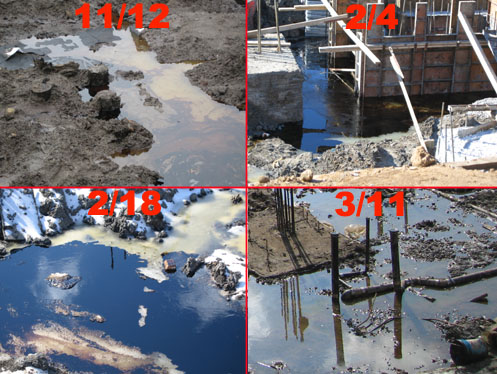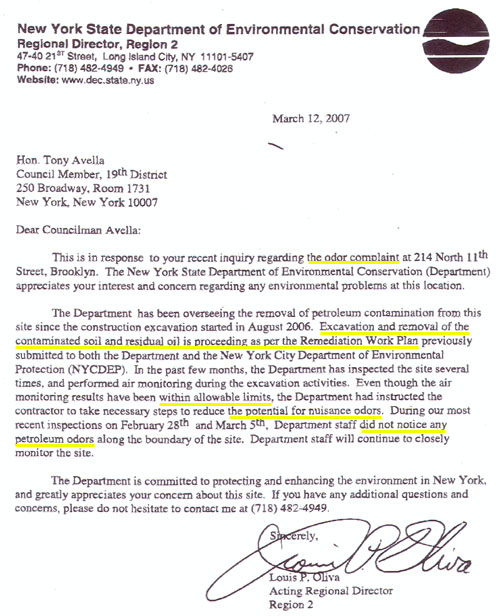Roebling Oil Field Update: Everything Is Under Control...

One of the politicians to take an interest in the state of things at the development site at N. 11th Street and Roebling in Williamsburg that we call the Roebling Oil Field (above, seen on four different dates) is Queens City Council Member Tony Avella. You can wonder why more Brooklyn officials aren't asking why oil has been oozing out of the ground in this corner of Williamsburg and whether it's something that ought to be of broader public concern, but that would getting away from our point.
The matter at hand is that CM Avella wrote the Department of Environmental Conservation, and they sent a letter back that seems to imply that the only thing people are worried about is are "nuisance odors" that have come from the site and that the clean up is under control. They say that "excavation and removal of contaminated soil and residual oil is proceeding as per the Redmediation Work plan." They add that during inspections on Feb. 28 and March 5 "the Department did not notice any petroleum odors" along the borders of the site. One might suggest they send people that aren't facing severe olfactory challenges, as we've been sniffing the borders of the site too and can assure the Department that, while the stink is diminished, it is not entirely gone. (If you believe the critical issue is the smell, which it isn't.) We recently got an email suggesting that the department's oversight of the Roebling Oil Field has been--shall we say--significantly less than zealous. In fact, our correspondent suggested that the oversight, well, stinks.
This begs the point, however. Environmental maps show a ruptured oil tank was under a building on a site now occupied by the N. 11th Roebling development. Community activist Phil DePaolo, who is a veteran of many Williamsburg battles, argues that there is a broader oil contamination issue in Williamsburg and cites the smell of oil coming from Meeker Avenue (under the BQE) and the strong odor of oil when it rains. (This is the same phenomenon reported by residents that live atop the Greenpoint oil spill.) Almost no environmental testing has been done to determine the extent of contamination in the neighborhood. Meanwhile, while this part of Williamsburg is a great distance from the notorious Greenpoint Oil Spill, no one is certain how far the 17-30 million gallons of underground Exxon/Mobil oil has spread. In theory, the water table could have carried it a great distance in the half century or so it has been sloshing under North Brooklyn. (Amazingly, the spill's full spread has never been mapped.) Or, the issue could be more localized spills dating back to more than a century of industrial use of many properties now being converted to residential use. In either case, one could certainly make the case for very rigorous public sector oversight and intensive testing to determine the true nature of the toxic threat to both longtime residents and new arrivals.

Related Posts:
Here's the Roebling Oil Field Building
Roebling Oil Field Update: Still Oily

<< Home